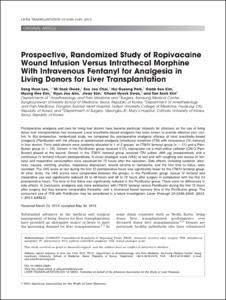Prospective, Randomized Study of Ropivacaine Wound Infusion Versus Intrathecal Morphine With Intravenous Fentanyl for Analgesia in Living Donors for Liver Transplantation
- Affiliated Author(s)
- 김태석
- Alternative Author(s)
- Kim, Tae Seok
- Journal Title
- Liver Transplantation
- ISSN
- 1527-6465
- Issued Date
- 2013
- Abstract
- Postoperative analgesia and care for living liver donors have become particular interests for clinicians as the use of living
donor liver transplantation has increased. Local anesthetic–based analgesia has been known to provide effective pain con-
trol. In this prospective, randomized study, we compared the postoperative analgesic efficacy of local anesthetic–based
analgesia (PainBuster) with the efficacy of opioid-based analgesia [intrathecal morphine (ITM) with intravenous (IV) fentanyl]
in liver donors. Forty adult donors were randomly allocated to 1 of 2 groups: an ITM/IV fentanyl group (n 5 21) and a Pain-
Buster group (n 5 19). Donors in the PainBuster group received 0.5% ropivacaine via a multi-orifice catheter (ON-Q Pain-
Buster) placed at the wound. Donors in the ITM/IV fentanyl group received ITM sulfate (400 lg) preoperatively and a
continuous IV fentanyl infusion postoperatively. A visual analogue scale (VAS) at rest and with coughing and rescue IV fen-
tanyl and meperidine consumption were assessed for 72 hours after the operation. Side effects, including sedation, dizzi-
ness, nausea, vomiting, pr uritus, respiratory depression, wound seroma or hematoma, and the first time to flatus, were
recorded. The VAS score at rest during the first 12 postoperative hours was significantly lower for the ITM/IV fentanyl group.
At other times, the VAS scores were comparable between the groups. In the PainBuster group, rescue IV fentanyl and
meperidine use was significantly reduced 24 to 48 hours and 48 to 72 hours after surgery in comparison with the first 24
postoperative hours. The time to first flatus was significantly reduced in the PainBuster group. There were no differences in
side effects. In conclusion, analgesia was more satisfactory with ITM/IV fentanyl versus PainBuster during the first 12 hours
after surgery, but they became comparable thereafter, with a shortened bowel recovery time in the PainBuster group. The
concurrent use of ITM with PainBuster may be considered in a future investigation. Liver Transpl 19:1036-1045, 2013.
- Department
- Dept. of Surgery (외과학)
- Publisher
- School of Medicine
- Citation
- Sang Hyun Lee et al. (2013). Prospective, Randomized Study of Ropivacaine Wound Infusion Versus Intrathecal Morphine With Intravenous Fentanyl for Analgesia in Living Donors for Liver Transplantation. Liver Transplantation, 19(9), 1036–1045. doi: 10.1002/lt.23691
- Type
- Article
- ISSN
- 1527-6465
- DOI
- 10.1002/lt.23691
- Appears in Collections:
- 1. School of Medicine (의과대학) > Dept. of Surgery (외과학)
- 파일 목록
-
-
Download
 oak-aaa-03700.pdf
기타 데이터 / 293.42 kB / Adobe PDF
oak-aaa-03700.pdf
기타 데이터 / 293.42 kB / Adobe PDF
-
Items in Repository are protected by copyright, with all rights reserved, unless otherwise indicated.